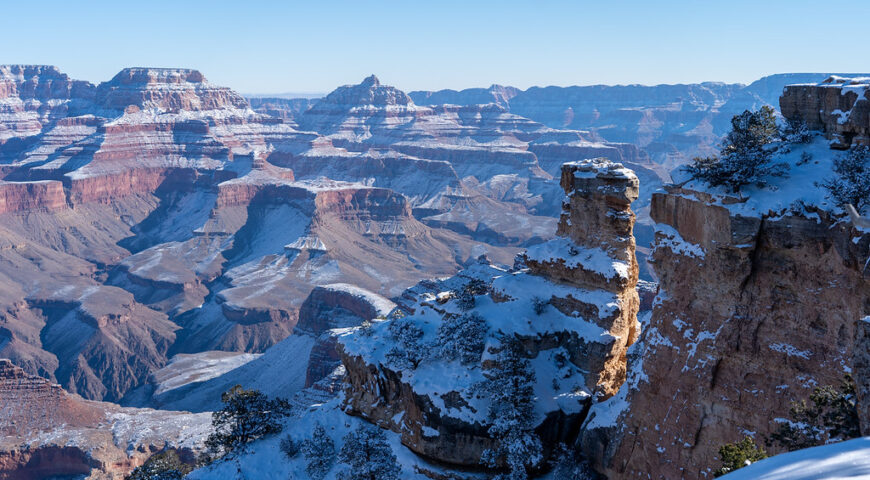
The Grand Canyon is much less crowded in January!
Table of Contents
Visiting Grand Canyon in January with a lot fewer crowds!
Explore the Grand Canyon’s Off-Season Adventures in January
One of the perks of visiting the Grand Canyon in January is that there are far fewer people than in the summer.
We all know that visiting the Grand Canyon in January also has its downsides, including the weather, and possible snowstorms in January.
The canyon’s snow cover, balmy temperatures, and low tourist numbers make the Grand Canyon a unique experience, offering beautiful views of the majestic canyon below.
Read on to check out these Grand Canyon January reviews and what to do at the Grand Canyon in January.
Is the Grand Canyon accessible to visitors during the month of January?
Grand Canyon National Park is open to tourists all year round. During the winter the North Rim is closed for security reasons. The South Rim is open year-round and has many beautiful Grand Canyon Lookout points. The South Rim of the Grand Canyon in January is a little different and you can experience the snow at the Grand Canyon.
How busy is the Grand Canyon in January?
The more popular South Rim is open year-round. Due to winter conditions, the Grand Canyon’s tourist rate remains at its lowest during these months.
So if you don’t want to be surrounded by too many tourists, winter is the best time to visit the national parks. With fewer tourists, winter visitors are more likely to experience the tranquility that the canyon has to offer.
Another advantage of winter, when there are few tourists, is that it is easier to book accommodation!
Is it a good time to visit Grand Canyon in winter?
There’s never a bad time to visit the Grand Canyon.
As long as you prepare for short days, cool temperatures, and unpredictable weather, you can enjoy visiting the Grand He Canyon in winter.
Winter is the best time to visit the Grand Canyon, with less crowds, clear skies, and cooler temperatures. I think the point to visit in winter is shoes. Don’t just wear sneakers as the snow will melt and get inside your shoes. Waterproof shoes are a must!
Make sure to pack the following if you are planning to visit the Grand Canyon in January:
- Waterproof shoes
- Winter Jacket
- Gloves, Hat, Scarf
- Thermal Layer, sweater, sweatshirt
- Shoes with a good grip
Does it snow in the Grand Canyon in January?
Yes, the Grand Canyon sees snow in January and the days are much shorter.
A January Grand Canyon storm can bring 50 to 100 inches of snow.
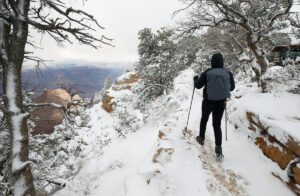
The snow cover contrasts with the clear, sunny skies and fresh air, providing perfect conditions to get outside and experience the beautiful scenery of the vast canyon and snowy Grand Canyon.
Is the Grand Canyon cold in January?
Yes, it gets cold in the Grand Canyon in January. January and February are the coldest months. Daytime temperatures range from 40 to 50 degrees, but nights can drop below freezing.
It will snow. At some point in the month, the village will have about 10 inches of snow. Also, sometimes there is only an inch or two of snow.
Things to do at the Grand Canyon in the Winter
In winter, you can enjoy the same activities as in the warmer months at the Grand Canyon. Yes, some hiking trails are closed due to freezing, but you can still enjoy the Grand Canyon in winter with warm clothing.
1. Visit the Visitors Centre to find out the conditions.
The visitor center is located just behind the South Entry Station on the South Rim and is open from 9 AM to 4 PM during the winter months.
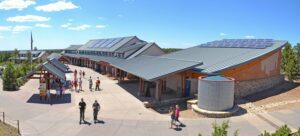
At the visitor center, you’ll be briefed on the day’s weather conditions, including whether there are trails that are safe to hike, whether some trails are closed, and which viewpoints are the safest to visit.
The visitor center also has a short film about the park, giving visitors a visual experience before they dive in.
Mother’s Point is a 5-minute walk from the Visitor Center. It’s the first choice for many travelers, especially in winter, due to its proximity to parking lots and the visitor center. It takes no effort or time to get to the viewpoint, so you can easily see the canyon even if you don’t want to endure the winter cold.
2. Take a Shuttle if it’s snowy and you don’t want to drive.
During the snowy season, it is recommended to take the shuttle bus to the viewpoint rather than drive yourself. If you have enough experience and are not confident about driving on snowy roads, it is safe to drive when the roads are clear. The shuttle is the best and safest choice, and you can call us now for the bus.

The Grand Canyon has two shuttle bus routes that give you the best views of the canyon, but the orange route (Kaiba Brim) is definitely the best for free transfers to the best spots. Orange shuttle buses run every 30 minutes from the visitor center.
During the route, the bus takes visitors to his five main viewpoints that offer beautiful views of the canyon. These viewpoints include Mother’s Point, Yavapai Geological Museum, South Kaibab Trailhead, Yaki Point, and Pipe Creek Vista.
3. Drive to Hopi Point, if not snowy and you want to drive
One of the must-see spots on the West Rim of the Canyon is off Hermit’s Road at Hopi Point. About halfway down the road for about seven miles is arguably one of the canyon’s greatest viewpoints.
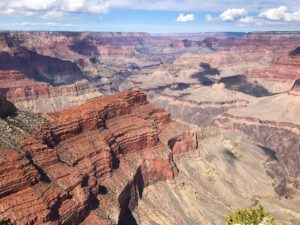
Hermit Road is only open to private vehicles during the winter months, making it a great time to plan your trip.
Hopi Point is one of the West Rim’s most popular vantage points, with breathtaking panoramic views of the Colorado River, Dana Butte, and vast canyons. Hopi Point is also voted one of the best places to watch the sunrise and sunset due to its expansive views.
However, when snow accumulates and roads are deemed unsafe for private vehicles, the park operates a shuttle bus to Hopi Point along Hermit Road. No matter what the weather, make sure to see this beautiful scenery.
4. Take a Short hike in the Grand Canyon
Hiking the Grand Canyon in winter can seem impossible, but here are some short hikes you can do. Most trails are very icy. So if you want to hike further, you will need extra equipment.
All hiking trails are supervised and open most days. Check with the visitors centre.
Take a hike to Shoshone Point
The trail begins at a discreet gate along Desert View Drive. The entire trail is only 1.7 miles, making it a short and easy hike during the winter months.
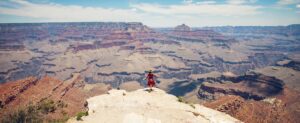
The trail runs along a dirt road with only a slight incline along the way. At the end of the trail, you will be rewarded with stunning panoramic views of the beautiful canyon below. The trail is also fairly private, making for a quiet and calming experience in nature for the most part.
Take a hike to Ooh Aah Point
About a mile down the South Kaibab Trail, a beautiful lookout point is a perfect place to end a short winter hike. The hike is short, but not necessarily easy.
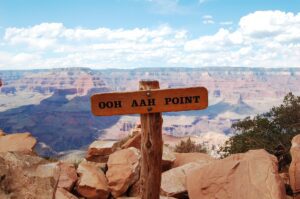
The hike to Ooh Aah Point is relatively downhill, so the return trip takes about twice as long. Therefore, in less rainy or snowy conditions, it can be a great hike for those looking for a bit of a challenge, along with great scenery along the way.
5. Drive the Hermits Rest Scenic Drive.
At the western end of the South Rim, Hermit Road is a popular seven-mile route that passes many scenic lookouts before ending at Hermit’s Rest.
The Grand Canyon operates shuttle buses along this route.
During the summer months, the Grand Canyon is busy and there is not enough parking, so you’ll need to take a shuttle. During winter the road is open to private vehicles.
Along this route are some of the best views the canyon has to offer, including views from Hopi Point, Mojave Point, and Pima Point.
6. Rim Trail – Visitors Centre to Village
A beautiful and easy 2.5-mile trail from the visitor center to Grand Canyon Village. The trail is paved and mostly flat, making it perfect for those who want to see the beauty of the canyon while staying on flat terrain.
There are many viewpoints along the way that add another beauty to the canyon experience. This trail is also great for those who enjoy hiking as it is generally easy and can be compared to a walk in the park – with the added bonus of canyon views!
7. Tusayan Museum and Ruin
The Tusayan Museum and Ruins, three miles west of Desert View Point, is one of Arizona’s most important archaeological discoveries.
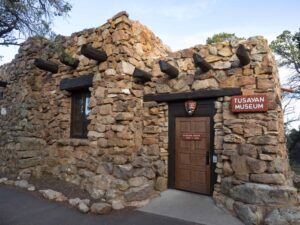
The ruins themselves include the ruins of a pueblo village believed to be over 800 years old. A museum located near the ruins has many exhibits designed to help visitors better understand the canyon’s unique history. Visiting museums and learning about over 12,000 years of rich archaeological history seems like the perfect way to spend his day in the balmy winter.
8. See the wildlife in the park
Many animals in this region have developed cold tolerance and adaptations. In winter, even more, animals can be seen foraging on the trails and forests.
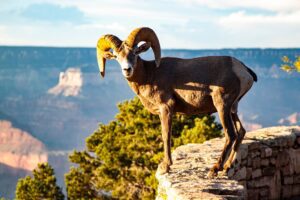
Mule deer, rock squirrels, moose, and ravens are popular spots in the canyon during this colder period.
9. Catch the Sunset at one of these points
There are many spots along the Grand Canyon that are considered the best spots to watch the sunset. Arguably two of the best places to sit and enjoy the sunset on a clear winter evening are Hopi Point and Yavapai Point.
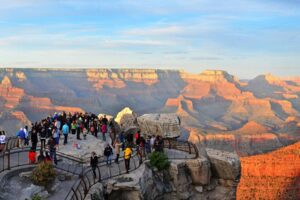
Hopi Point is one of the most popular spots on the South Rim where you can watch both sunrise and sunset. This is mainly due to the incredible panoramic view of the canyon that can be seen from this point. Make any sunrise or sunset truly magical. Visiting the Grand Canyon in winter has the advantage of being the best place to watch the sunset without the crowds of tourists. Make the experience a little more exciting.
Yavapai Point is a popular spot for watching the Grand Canyon sunset. A short walk from the visitor center, Yavapai Point is the perfect spot for spectacular canyon views and sunsets.
Conclusion
Visiting the Grand Canyon in January is a unique experience, with fewer crowds and the opportunity to see the park covered in snow. While the weather can be cold and there is the possibility of snowstorms, the clear skies and fresh air provide the perfect conditions to enjoy the beautiful scenery of the canyon.
The South Rim of the Grand Canyon is open year-round and has many lookout points to take in the views, and the visitor center is a great resource for information on the day’s weather conditions and safe trails and viewpoints to visit. Winter visitors should be prepared with waterproof shoes, warm clothing, and a good grip on their shoes. Despite the colder temperatures, there are still plenty of activities to enjoy at the Grand Canyon in the winter, including visiting the visitor center, taking in the views from Mother’s Point, and exploring the park by car. Overall, winter is a great time to visit the Grand Canyon and experience its beauty in a different way.
Make your visit to the Grand Canyon in January even more memorable by booking a tour with Christianson Tours. Our experienced guides will ensure that you have a safe and enjoyable trip and help you make the most of your visit to the park. Don’t miss out on this unique opportunity to experience the Grand Canyon in a different way – book your tour with Christianson Tours today!


